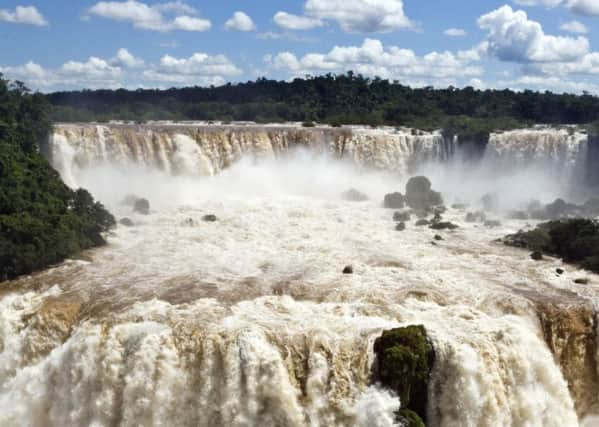Travel review: Peaks and falls in Argentina


When I travel I thrive on the unexpected. The fresh stimulus of new places and people is one thing, but I want more. I want to be astonished. Sure enough, 10,000ft up in the Andes and we hit a roadblock of policemen. Our plans had to change. We had to wait for the procession to pass. It was in a mountainous outpost called Leon, a gaucho community celebrating their historic victory over the Spanish.
There was no “Chinese Olympics” precision as the soldiers marched amusingly out of step, past dignitaries who applauded downwards from their dais, too self-important to notice their refreshments being refilled. Then amidst a gang of hardened gauchos on horseback, strode a tiny boy. No more than five surely. The ladies were on side-saddle, but surprising us all was this youth’s composure, astride a horse fit for an adult, giddying it up with an assurance utterly belying his age. And behind him a girl of much the same age, serene and composed on top of her steed. Wonderful!
Advertisement
Hide AdAdvertisement
Hide AdAll this in what is truly a hybrid country both of nature and population. On the one hand there are Pampas, the peaks of Patagonia, the Iguazu Falls and the Andes. Then there is the European influx and the Incan descendants.
Nowhere more than in the capital is Argentina a baffling mix of European immigrants and indigenous tribes. I love Buenos Aires. It is a proper fully fledged city: glamorous, sophisticated, troubled and yet honest. The Italians are the predominant European immigrants. They wanted political freedom and, above all, land. The city enjoyed a belle époque between 1880 and 1930, with wealth pouring in at its height in the 1910s from England, keen to get after the quality of Argentina’s beef. Recolleta is a district with Parisian overtones, as harmonicas are squeezed to entertain those who sit, stretch and watch the world go by.
I got a ride to one of the two rival football clubs, Boca Juniors, where famously Diego Maradona started. With no seats allocated for the opposition’s fans, the partisanship is deafening.
My ears were better suited to the Tango evening I attended but not my eyes. Dramatic but empty, lacking narrative and with some strange back kicks, it is a man’s dance, with the lady playing second fiddle as the movement of her legs obeys his masterful hand directions. Playful perhaps but all gesture and baroque with nothing convincing or compelling. Brutal, sexy at best but never sensual or romantic. Jerky, ungraceful and sharp. It needs Tennessee Williams to exploit its steamy potential.
Advertisement
Hide AdAdvertisement
Hide AdTime to cool down in the mountains. I flew to Salta and stayed at Finca Valentina, 1,400 metres above sea level and owned by the charismatic ex-Milanese banker Fabrizio, who attracts many top celebrities including the Prada family.
I took a bus trip up from Salta higher into the Andes at their broadest point. I was back with nature and of course the ever present llama. With horses, sheep, oxen and goats introduced only at the time of the colonising Spaniards, the llama was vital and its ancestor the guanaco, the tallest of the llama species, was very adaptable, performing both at sea level and 4,000 metres altitude.
Reaching a further 20ft upwards are fabulous cacti in Los Cardones National Park. Twice my height, and I’m six foot three, they nonetheless grow only at two centimetres per year.
In the Reserva Provincial Natural Quebrada de las Conchas, a dried up riverbed that once curiously was part of the Atlantic Ocean, has rocks just like tiramisu, among which are a number of plants and herbs with rather more medicinal benefits: the “falsa higera” which is a dye that helps treat vitiligo of the skin; the “brea”, a gel that is used to make chewing gum; the iris which is helpful for eye styes; and the “retama”, a kind of yellow broom which helps rheumatism and, bizarrely, sweaty feet!
Advertisement
Hide AdAdvertisement
Hide AdI took a flight to Iguazu, where the famous falls spill more widely than anywhere on earth. From waterfalls to wetlands, I reached the Puerto Valle. I loved staying here. It’s an 18th century estancia, run by the charming Nicolas, with its own private lake fit for wildlife and fishing. It is in a protected area that also connects the Jesuit missionary ruins. The canal was built by Jesuits to level the flooding. In the Camelote wetlands there are 350 species of birds, including herons, big igrets, cowbirds and even toucans at the end of the year.
Plane spotters may be on the wane but twitchers, like middle-aged cyclists, are a breed that is very much on the increase. It’s clearly an art to discern from which tree the warbling emanates. Here for the discerning are capybara the world’s largest rodent, though quite cuddly, and pirincho birds preening themselves to look like Rod Stewart. Astonishing!